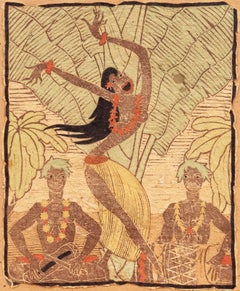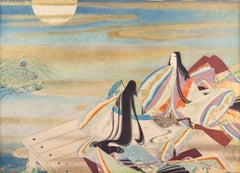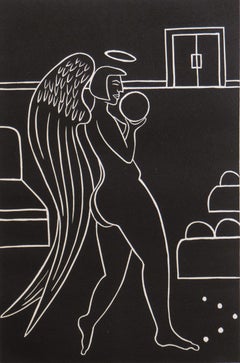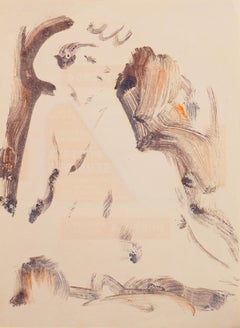Want more images or videos?
Request additional images or videos from the seller
1 of 8
Hal Steward Wilcox'Tahitian Dancer with Drummers', California Artist, Honolulu, Mexico, San Diego
$850List Price
About the Item
- Creator:Hal Steward Wilcox (1892 - 1982, American)
- Dimensions:Height: 9 in (22.86 cm)Width: 7.25 in (18.42 cm)
- Medium:
- Period:
- Condition:minor surface stains, irregular edges, small hole at lower right; unframed.
- Gallery Location:Santa Cruz, CA
- Reference Number:1stDibs: LU3441755853
About the Seller
5.0
Gold Seller
Premium sellers maintaining a 4.3+ rating and 24-hour response times
Established in 1982
1stDibs seller since 2013
750 sales on 1stDibs
Typical response time: 1 hour
Authenticity Guarantee
In the unlikely event there’s an issue with an item’s authenticity, contact us within 1 year for a full refund. DetailsMoney-Back Guarantee
If your item is not as described, is damaged in transit, or does not arrive, contact us within 7 days for a full refund. Details24-Hour Cancellation
You have a 24-hour grace period in which to reconsider your purchase, with no questions asked.Vetted Professional Sellers
Our world-class sellers must adhere to strict standards for service and quality, maintaining the integrity of our listings.Price-Match Guarantee
If you find that a seller listed the same item for a lower price elsewhere, we’ll match it.Trusted Global Delivery
Our best-in-class carrier network provides specialized shipping options worldwide, including custom delivery.You May Also Like
Dogs 2 - Contemporary Woodcut Print, Figurative, Black & white, Polish artist
By Zdzislaw Wiatr
Located in Warsaw, PL
ZDZISŁAW WIATR (born 1960)
He graduated from the Academy of Fine Arts in Cracow, at the Faculty of Graphic Arts in Katowice, where in 1986 he received a diploma with the honourable m...
Category
21st Century and Contemporary Contemporary Still-life Prints
Materials
Paper, Woodcut
$963
H 29.93 in W 22.84 in
Horses - XX century, Woodcut print, Black and white, Figurative-abstract
By Ludwik Maciąg
Located in Warsaw, PL
LUDWIK MACIĄG (b. 1920- d.2007) Studied at the Faculty of Painting at the Academies of Fine Arts in Cracow and Warsaw. He graduated in 1951. He was a professor and a dean of the Facu...
Category
Late 20th Century Other Art Style Figurative Prints
Materials
Paper, Woodcut
Lord on the Sand Castle - XX century Black & White Woodcut Print
By Franciszek Bunsch
Located in Warsaw, PL
Illustration for Jules de la Medelen's "Lord on the Sand Castle" ("Le Marquis Des Saffras")
FRANCISZEK BUNSCH (born in 1926) Franciszek Bunsch was born in Bielsko in 1926. He studie...
Category
1950s Contemporary Portrait Prints
Materials
Woodcut, Paper
$325
H 2.56 in W 3.94 in
Lord on the Sand Castle - XX century Black & White Woodcut Print
By Franciszek Bunsch
Located in Warsaw, PL
Illustration for Jules de la Medelen's "Lord on the Sand Castle" ("Le Marquis Des Saffras")
FRANCISZEK BUNSCH (born in 1926) Franciszek Bunsch was born in Bielsko in 1926. He studie...
Category
1950s Contemporary Portrait Prints
Materials
Woodcut, Paper
$325
H 3.15 in W 4.14 in
Entrance to garden. Black and white woodcut, Figurative, Polish artist
By Franciszek Bunsch
Located in Warsaw, PL
Black and white figurative woodcut print by Polish artist Franciszek Bunsch. Print comes from limited edition, it is numbered and signed by the artist.
FRANCISZEK BUNSCH (1926-2025...
Category
Early 2000s Other Art Style Figurative Prints
Materials
Woodcut, Paper
Faces and masks. Black and white print, Figurative, Polish artist
By Franciszek Bunsch
Located in Warsaw, PL
Black and white with figurative woodcut print by Polish artist Franciszek Bunsch. Print comes from limited edition, it is numbered and signed by the artist.
FRANCISZEK BUNSCH (1926...
Category
Early 2000s Other Art Style Figurative Prints
Materials
Woodcut, Paper
$337
H 5.71 in W 3.94 in
EROTIC DREAM, Woodcut, Limited Edition, signed by the Artist
Located in Palm Desert, CA
"EROTIC DREAM" (1976) by Norbert Matzdorf
Woodcut print on paper
Limited Edition, numbered (10.3), dated and hand-signed by the artist
27,9 x 38,3 cm
Norbert Matzdorf (1951 – 2013) ...
Category
1970s Figurative Prints
Materials
Paper, Woodcut
$200
H 15.08 in W 10.99 in D 0.01 in
French Woodcut - La Mer et Les Fleuves
By Colette Pettier
Located in Houston, TX
Absorbing black and white woodcut of a nude female figure in the water surrounded by sea life and small figures by French artist Colette Pettier, 1936. Signed, dated and numbered 49 ...
Category
1930s Figurative Prints
Materials
Paper, Woodcut, Ink
"Daikoku, Dieu de la Richesse" Japanese Style Woodblock Print
By Paul Jacoulet
Located in Austin, TX
A woodblock print of a Japanese geisha in elegant clothing against a yellow decorative background.
By Paul Jacoulet
15.5" x 12" Woodblock print on paper
Framed Size: 22.5" x 18.5"
...
Category
Mid-20th Century Figurative Prints
Materials
Paper, Woodcut
$2,500
H 15.5 in W 12 in
"Actor Kataoka Nazaemon as Oboshi Yaranosuke Leader of the 47 Ronin" Portrait
By Utagawa Kunisada (Toyokuni III)
Located in Austin, TX
Artist: Utagawa Kunisada "Toyokuni the Third" (Japanese 1786 - 1864)
Page Size: 14 x 9.5 in.
Frame Size: 21 x 16.25
Translation of Calligraphic Japanese Text:
大星由良之助 Ōboshi Yuranosu...
Category
Mid-19th Century Portrait Prints
Materials
Paper, Woodcut
More From This Seller
View All'Tahitian Dancer with Drummers', California Artist, Honolulu, Mexico, San Diego
By Hal Steward Wilcox
Located in Santa Cruz, CA
Signed lower right, "Hal Stuart" (American, 1892-1982) and inscribed "Tahiti".
Color woodblock print showing a Tahitian dancer in traditional dress accompanied by two musicians play...
Category
1940s Figurative Prints
Materials
Paper, Woodcut
'Musicians Viewing the Full Moon', Large Japanese Color Woodblock Print, Biwa
By Ogyu Tensen
Located in Santa Cruz, CA
Signed, lower right, with artist's chop mark in Hiragana, 'Tensen-e' 天泉絵, for Ogyū Tensen 荻生天泉 (Japanese, 1882-1947)
A large, early-20th-century, hand-colored Japanese woodblock sho...
Category
1920s Figurative Prints
Materials
Paper, Fiberboard, Woodcut
'Bowling Angel', Post Impressionist, Portland Museum, Albright-Knox Gallery
By Dan May
Located in Santa Cruz, CA
Signed lower left, 'May' for Dan May (American, 1952-2019) with number and limitation, '1/50'. Titled, lower center, 'Bowling Angel' and dated, lower right, '2003'.
Sheet dimensions:...
Category
Early 2000s Figurative Prints
Materials
Paper, Woodcut
'Young Woman Seated', Paris, Louvre, Salon d'Automne, Ac. Chaumière, LACMA, SFAA
By Victor Di Gesu
Located in Santa Cruz, CA
Stamped, verso, with estate stamp for Victor Di Gesu (American, 1914-1988) and created circa 1955. Printed on one of the artist's characteristic sardine-can wrappings from the Monter...
Category
1950s Figurative Prints
Materials
Paper, Monotype
'Autumn', Hand-colored Lithograph, listening to music under the tree
Located in Santa Cruz, CA
An early twentieth-century, hand-colored lithograph showing an idyllic scene of two young lovers in medieval dress seated in a rural bower beneath fruiting grape vines and a spreadin...
Category
1920s Animal Prints
Materials
Paper, Lithograph
'The White Clogs', Paris, Louvre, Salon d'Automne, Ac. Chaumière, LACMA, SFAA
By Victor Di Gesu
Located in Santa Cruz, CA
Created by Victor Di Gesu (American, 1914-1988) circa 1955 and stamped, verso, with Victor di Gesu estate stamp.
Winner of the Prix Othon Friesz, Victor di Gesu first attended the L...
Category
1950s Figurative Prints
Materials
Paper, Monotype
Recently Viewed
View AllMore Ways To Browse
Kim Jong Un
Klimt Embrace
L Jambor
Last Supper Lithograph
Le Joueur De Flute
Lech Poster
Leonda Finke
Leonor Fini Sphinx
Leroy Neiman Artist Proof
Leroy Neiman Cafe
Leroy Neiman Football
Leroy Neiman Frank Sinatra Prints
Leroy Neiman Frank Sinatra
Leroy Neiman Sailing
Lichtenstein Art Critic
Linogravure Picasso
Luis Salazar
M Utrillo



